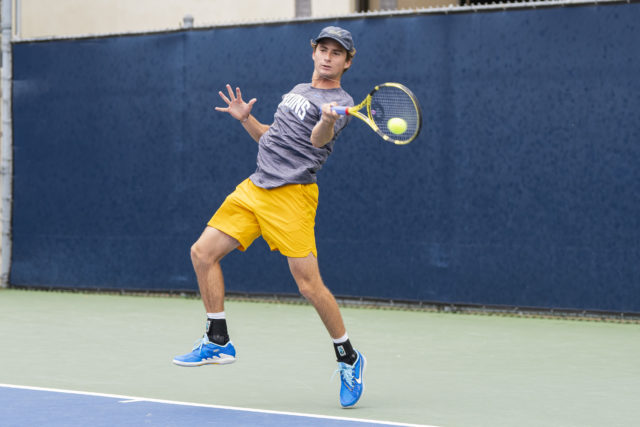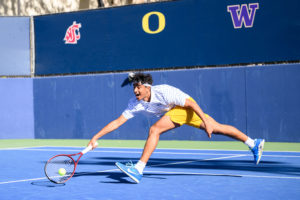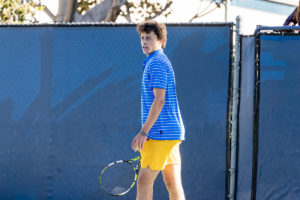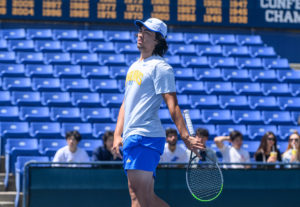Most recruits enter their college tennis careers with extensive hard-court competition under their belts.
Gianluca Ballotta didn’t fit that mold.
While UCLA men’s tennis’ rising sophomore has played high-level tennis for years, the 19-year-old Peruvian did so almost exclusively on clay. Ballotta had only competed on hard courts once prior to his arrival in Westwood, coach Billy Martin said.
Ballotta said the transition was rocky at first, as the change in terrain and difficulty in moving and sliding took a toll on his knees.
“I felt a little bit slower here at first, so it was very tough,” Ballotta said.
Martin also noticed Ballotta’s struggles, emphasizing that there was a problem with him standing too deep and not returning the ball closer to the baseline.
But as the season progressed, Martin saw marked improvement in his positioning, net play and serves.
“He started returning closer to the baseline,” Martin said. “We worked very hard on his volleys – I think those got a lot better. His big improvement since January was his serve.”
Ballotta didn’t take on this transition alone.
Along with Martin, numerous teammates have played on clay courts in the past, allowing them to share wisdom.
Rising junior Giacomo Revelli said he plays on clay every summer and described how he modifies his technique for his groundstrokes on each court.
“On the clay, you need to hit with a bit more shape to allow for the ball to kick up. On the hard, it’s a little less reactive, so it’s more effective to hit through in flatness,” Revelli said. “The ball flight is something that, on an average shot, I would change going from clay to hard.”
Guidance from veteran teammates such as Revelli and the coaching staff was invaluable, as they taught him to change his groundstrokes to flatter shots with less topspin, Ballotta said.
Revelli praised how receptive Ballotta was to advice as well as how he preserved aspects of his clay game that translate to the hard courts.
“He maintained his heavy hitting,” Revelli said. “But at the same time, I was impressed with how he developed certain weapons like stepping into the court, coming in and volleying.”
Ballotta’s efforts quickly came to fruition.
With rising junior Alexander Hoogmartens out in early February because of an undisclosed injury, Ballotta ultimately competed in the remaining 18 singles matches, winning nine out of his 12 completed matches.
But when Ballotta ventured into doubles play in the latter part of the season, he encountered another challenge. He said the one-set matches gave a completely different rhythm of play, forcing him to stay laser focused for every point.
“That was super weird for me,” Ballotta said. “I’m used to playing two sets, at least, in every single tournament I’ve been playing so far.”
By the end of the year, Martin said he was pleasantly surprised with the smoothness of his transition.
This season gave a glimpse at the player Ballotta is shaping up to be, and although he slotted in at No. 5 singles for the majority of the matches, Martin hinted at future opportunities for him to come into form.
“Quite honestly, maybe he should’ve been playing higher,” Martin said. “I have a lot of confidence in him moving into next year.”






Comments are closed.